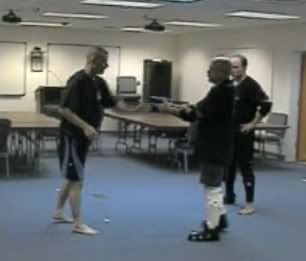
Every martial art has it's strengths and weaknesses (see Ain't none of it is real! and some of the referenced links). One obvious aspect of martial arts around the world is the tendency to focus on one area and/or range of unarmed or armed combat. Even among those instructors whose systems have combined the unarmed areas of striking, grappling, or standing clinch, such as Jiu-Jitsu, Hapkido, and Jeet Kune Do, there is a tendency to favor one above the other, depending on the comfort level. For some, it's a range, as in a sport grappler like BJJ or Judo favoring either throws or groundwork, or a TKD player favoring kicking range and striking (despite the fact that all striking ranges are included in TKD). How to you make the transition from one range to the other?
We know that there's a definite need to be able to fight in all ranges. A situation may start with a shove then punch (standing striking), then the attacker may pin the defender against a wall (standing grappling) while trying to pummel him, then the fight may go to the ground (groundfighting, which is a combination of grappling and striking on the ground). It's often said that most fights end up on the ground, but how does one get there? Obviously, the combatants have to transition through the ranges. The questions for a martial artist interested in self defense are, "How do I integrate the ranges and areas of fighting," and, "What's the best way to train for that?"
Stephan Kesting gives his take in his excellent instructional article, The MMA Formula: Striking + Takedowns + Groundwork and his blog post, Integrating Striking, Wrestling & Grappling.
The reason you want to train each area separately (at least some of the time) is so that you can develop skills in that area, without relying on your strengths in the other areas. If you always blend standup and ground, grappling and striking, then your weaknesses in one area might remain hidden for a long time.
The reason you want to combine striking, wrestling and grappling in your training (at least some of the time) is to simulate a real fight as closely as possible and also to find out if you have developed any bad habits in your training. For example, if your wrestling stance is extremely low with your hands on your knees, or if you use your closed guard without breaking your opponent's posture posture or controlling his head and arms, then a brief MMA sparring session will definitely be an eye-opening experience for you.
If there isn't an MMA school near you then combining strikes with your wrestling with your grappling is going to be difficult. The boxers you train with will only want to box, the wrestlers will only want to wrestle.... So you may need to train these areas independently until you can either find an MMA school or some training partners who are willing to to cross train. Even if you are training them separately you are still laying solid foundations for later, so this is NOT wasted effort.
This is one way that sport training can be compatible with Combatives or self-defense-oriented martial arts: MMA builds on this throughout it's skill sets. For self-defense, an ideal way of training for the integration (I strongly agree with Kesting that you have to train and learn the individual skill separately to excel at them) is scenario-based training, and handicap sparring. Build on your strengths, learn the other ranges and areas of skill (including knives, clubs, and firearms), then drill them together. Add in multiple opponents and mixed weapons with multiple opponents. Get outside of your comfort zone.
For more information:
Todays TDA Tip: Handicap Sparring Key to Improvement
Handicap sparring: Striker vs Grappler
The Submission Trap
Cung Le video - Great Transition Between Ranges
Boxing for Self-Defense and MMA
Transition Into All Striking Ranges
THE ILLUSION OF REALITY (PTI)
THE ILLUSION OF REALITY (PT II)
W. Hock Hochheim, the Interview Begins
Air Guns and Self-Defense Training
Components of "reality training" explained
How One Barroom Encounter Changed One Cop's Views On Fighting
Practicality in Training

No comments:
Post a Comment